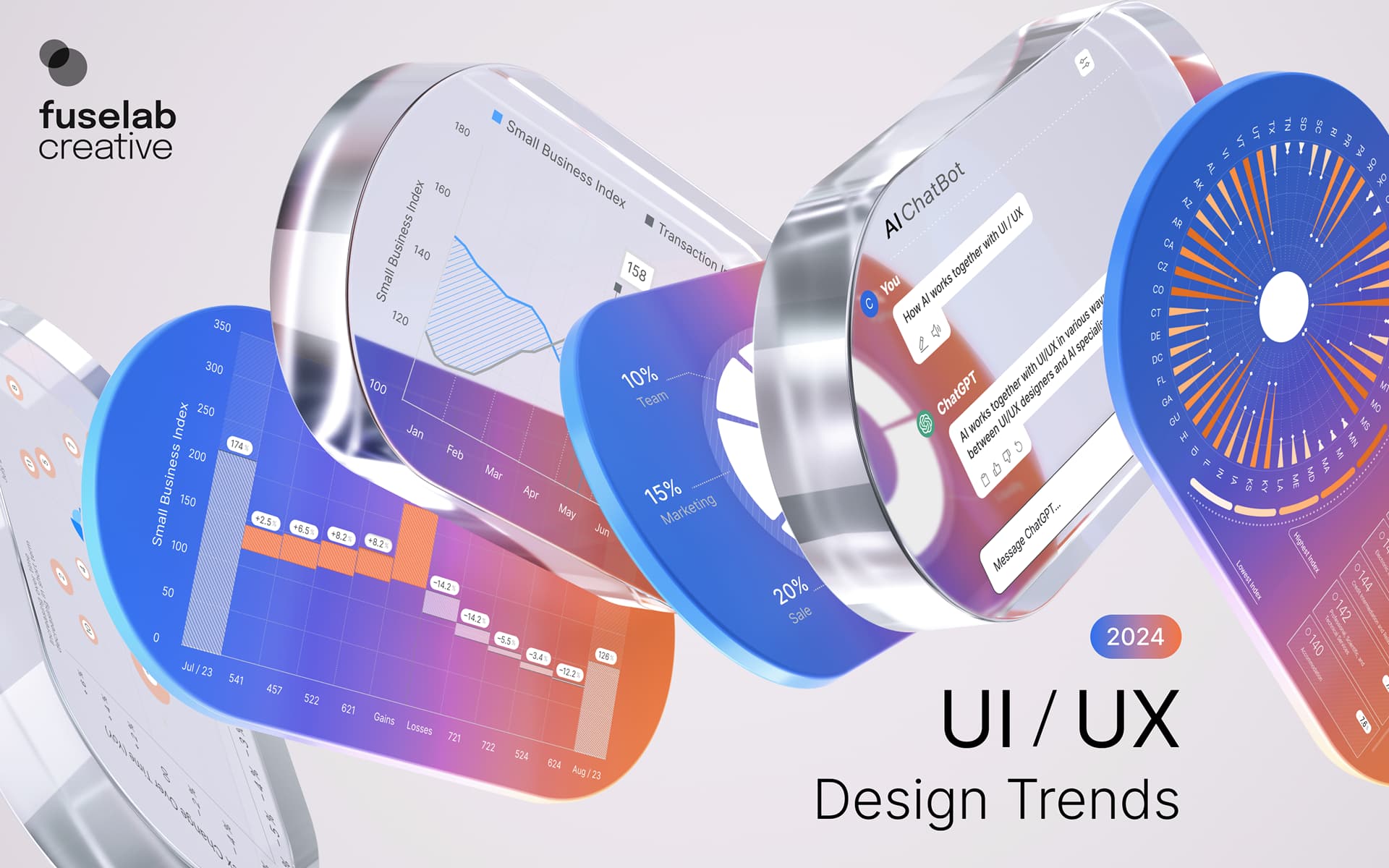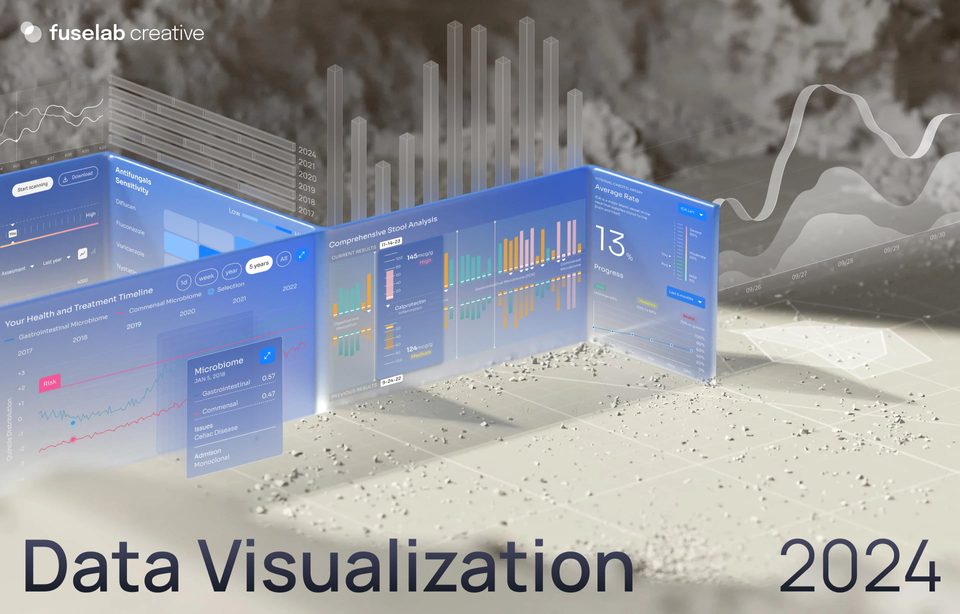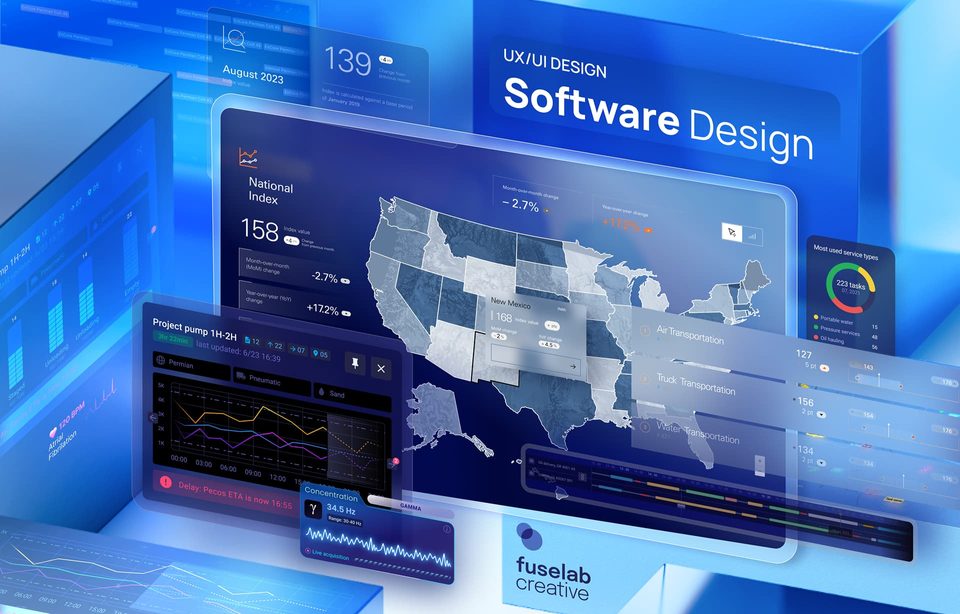UI/UX Trends 2024: Navigating the Future of Digital Design

![]()
Digital has emerged as the new frontier of the design world.
In a world where most of our lives are online, HOW we experience these interactions has become paramount. What was once a functionality is now expected to please the eye and ease the way.
As digital ecosystems expand and become more ubiquitous, design and UI/UX processes have also evolved to fit the new demands of the technology and its users. In this article, we look at some of the user interface design trends that are set to dominate 2024 and define the UI/UX best practices of the near future.
20 UI and UX Design Trends for 2024
-
Microinteractions: The Devil is in the details
Microinteractions are becoming increasingly common and are slated to become one of the critical graphic design trends in 2024. These subtle animations and transitions can make simple online activities more interactive and meaningful. These small animations provide instant feedback, guide users through tasks, and add elements of fun, color, and motion to key stages of the user journey.
-
Neumorphism: mobile UI design trend that keeps getting more popular
Neumorphism, a design trend that blends skeuomorphism and flat design, started in 2019 and shows no sign of abating. It has redefined the way we perceive digital interfaces; bridging the gap between realism and minimalism, it offers users a visually rich and intuitive interface. Neomorphism uses subtle shadows and highlights to create a 3-dimensional illusion that adds an exciting layer of realism to mobile app design.
An example is a weather app where raindrops on the screen react to touch, creating a lifelike feel.
-
Voice User Interface (VUI): Conversations That Resonate
As voice technology finds more and more users, the role of Voice User Interface (VUI) comes to the fore. Designers must now consider weaving conversational experiences into their interfaces as default, giving users an option to interact with app functionalities via natural language. From voice-activated commands to chatbot-driven interactions, VUI makes digital engagement more intuitive, efficient, and accessible.
One typical example of VUI is a smart home app where users control their devices by simply speaking commands, turning the mundane into magic.
Voice UI trends provide several advantages. They allow for hands-free interaction, which can be extremely useful in cars or while handling multiple devices. It has made the Internet and apps more accessible to different types of users, such as those who might find the app navigation confusing or are visually impaired. Voice interactions also reduce time as they are faster than typing or navigating through menus. Lastly, voice interfaces can integrate different apps, devices, and interfaces more seamlessly and effortlessly.
-
Emotional Design: Stirring the Heartstrings
User experience trends are rapidly moving beyond functionality. Designers are now attempting to tap into the emotional realm of the users. Emotional design aims to elicit specific feelings or responses through aesthetic elements such as color schemes and images or through animations, interactive components, and text-based content.
For example, picture a meditation app that adjusts its color palette and visuals based on the user’s mood, promoting relaxation and emotional well-being.
-
Gesture-Based Navigation: The Foundational App UI trend for 2024
In the era of touchscreens, gesture-based navigation is the latest UX design trend to become the norm. Designers are moving away from traditional buttons, embracing swipes, pinches, and taps to bring seamlessness to user interactions on touchscreen devices such as tabs or smartphones. This trend simplifies user interactions and adds a layer of intuitiveness to the overall experience.
A basic example we use on our phones almost every day is a photo gallery app where we can swipe left or right to navigate through images and pinch to zoom in for a closer look.
-
Personalized User Journeys: Tailoring Experiences
Personalization is a growing trend across the entire digital and virtual world, so it is no surprise that it is a key UI/UX design trend, especially in the coming year.
By leveraging data such as granular user interactions and browsing patterns and adding technologies like machine learning and AI, designers are creating personalized experiences that build customer loyalty and a feeling of kinship.
Personalization extends from adaptive content to tailored user interfaces, for example, in a news app curating articles based on user preferences and reading habits for each subscriber.
Businesses are clear beneficiaries of the personalization UI/UX trend as personalized experiences increase conversion rates online, save time, effort, and money by focusing only on a targeted cohort of customers, and foster a sense of brand retention and loyalty with the current customer base.
-
Augmented Reality (AR): Bridging Real and Digital Worlds
Designers have upped the ante for building immersive experiences by integrating AR and VR into mainstream UI/UX design best practices. In 2024, expect to see more apps with AR enhancing user experiences that overlay digital information onto the physical world. From virtual try-ons in e-commerce to navigation prompts in travel apps, AR breaks barriers and blurs the lines between reality and the digital realm.
We can already see real-life examples of AR/VR integrations with businesses, such as IKEA’s app, where users can virtually place items in their living space before purchasing.
AR/VR goes beyond shopping to enhance interactions in education, entertainment, product design, simulations and training, and more. The technology allows users to learn while doing and interacting instead of by reading and hearing.
-
Gamification: Adding Fun to Web Design Trends in 2024
Talking of AR/VR integrations naturally leads us to gamification as one of the most popular trends in UI design. To freshen up jaded customer palettes and add product differentiation, companies are exploring gamification elements to ensure higher customer attraction and retention. Designers are adding leaderboards, collectibles, small games, and similar elements to bring fun and competition and to keep users more engaged.
-
Biometric Authentication: A Personal Touch
Digital expansion and security concerns grow in tandem. As more and more bits of our daily lives enter apps and programs, the concerns around protecting our virtual selves also increase. Designers working with the latest UI/UX trends must consider how they want to add security to their products in the most unobtrusive yet functional manner. This is where the traditional passwords and PINs are being replaced by biometric authentication. Fingerprint scans, facial recognition, and even behavioral biometrics are becoming integral to the current UI/UX design trends, providing a seamless and secure user experience. In 2024, expect these personalized authentication methods to become ubiquitous.
An example of the same is how a banking app verifies your identity through a combination of facial recognition and a quick fingerprint scan.
-
3D: Adding a new dimension to the design
A key challenge designers have grappled with is breaking out of the 2-dimensional space and adding depth and perspective to their interfaces. New UI/UX design trends depend on floating menus, layered illustrations, and other 3D elements to breathe life into digital spaces, offering users an immersive and captivating experience. We have all seen shopping apps where products rotate in 3D; now, the challenge is to take it to other industries meaningfully.
-
Green Design: UI/UX design trends in 2024 become Earth-first
Climate conversations and climate concerns are increasing day by day. It is now impossible to end a day without finding a new piece of climate news on our feeds. Considering increasing climate issues, the latest UI design trends include a solid push towards embracing sustainability.
Green design involves using eco-friendly color schemes, optimizing energy consumption, and integrating features that encourage eco-conscious behavior. This trend not only aligns with environmental values but also creates a positive user perception.
A simple example of the green design approach is a fitness app that rewards users with virtual trees for achieving fitness goals, contributing to a virtual forest that reflects real-world environmental efforts.
-
Data Visualization: Making Sense of Complexity
Data is everywhere. In fact, it wouldn’t be wrong to say we are drowning in it – figuratively! Every click is recorded somewhere and distilled into data pipelines. However, instead of aiding the business, too much data tends to cloud decision-making unless represented in a comprehensible and engaging manner.
A vital part of the UI/UX design revolves around making this data more understandable with visually appealing graphics, charts, diagrams, or heat map data visualization. This trend aids users in understanding and interpreting data effortlessly. Think of a finance app where intricate financial data is transformed into interactive charts, making budget analysis a breeze.
-
Motion Design: Integrating Movement Across the Board
Design is no longer static; users expect motion to be integral to their apps and websites. To cater to this demand for animation, designers have turned to simple format solutions such as “Lottie,” an open-source animation file format used to create lightweight, scalable vector graphics animations. Lottie files are very popular with designers who use them to add high-quality, light graphics to any platform.
-
AI Integration: Designing for a Smarter Future
Artificial Intelligence (AI) is added – in some form or another – to many apps and digital products we use daily. From Spotify preferences to Amazon recommendations, we have come to rely on apps to tell us what else we can engage with.
AI-powered tools analyze user data and behavior to provide insights, and increasingly, it is becoming the work of designers to incorporate this information into a more user-centered and data-driven design.
The year 2024 marks the start of an era of hyper-personalization, where AI is used to dynamically adjust interfaces in real-time by parsing user actions, preferences, and past interactions. This AI evolution extends from tailoring content recommendations to creating adaptive user interfaces, fundamentally changing how users interact with digital offerings.
(When it comes to staying at the forefront of technological advancements, don’t forget the rapidly growing metaverse. Find out how UI/UX design for Metaverse can adapt your product to attract audiences in the metaverse.
-
Accessibility: Democratizing Digital Products
Accessibility as a topic of web UI trends will continue to gain momentum in 2024. As digital devices and tools become more commonplace, it has become imperative that they also become more inclusive.
Designers now need to consider how their apps will be used by diverse users, such as people with disabilities and those who use different languages or have various educational backgrounds.
Design trends in UI are now routinely incorporating features like screen readers, keyboard navigation, high-contrast modes, and multilingual options. Designers must also consider technological differences that users might face, for example, low network connectivity in certain areas or different device configurations.
-
Dark Mode: A Nighttime Affair
Dark mode has proved to be a design choice that’s here to stay. Beyond reducing eye strain, dark mode adds a touch of sophistication to interfaces and conserves battery life. In 2024, we expect designers to incorporate dark mode as a standard feature across various applications, enhancing usability in low-light environments and providing a sleek aesthetic.
At the moment, dark mode is most popular on messaging apps or reading apps, where the screen adapts automatically to the time of day and switches seamlessly to dark mode as the sun sets.
-
Progressive Web Apps (PWAs): The Best of Both Worlds
Built using web technologies like HTML, CSS, and JavaScript, Progressive Web Apps (PWAs) offer features typically associated with native apps, such as offline functionality, push notifications, and home screen installation. They allow users to enjoy the app without downloading it and help expand the user base, especially when device owners hesitate to download and install an app. Both Telegram and WhatsApp have hugely popular PWA versions of their app.
-
Human-Centered Design: Putting Users First
Apps started as extensions of businesses or websites. While they wanted to sell to or attract users, the early iterations were designed with a functionality-first approach. As competition for customers’ mind space has increased, UI design inspiration has found a new source in the users themselves.
The pivot to human-centered design is underway. UX/UI design trends in 2024 will see designers placing the user at the core of every decision, empathizing with their needs and preferences.
The approach will make the dashboard interface designs visually appealing as well as functionally intuitive, with the ultimate goal being user satisfaction.
-
Building in Seamlessness: Designing responsive and platform-agnostic apps
Responsive and cross-platform digital products aren’t new; however, in 2024, we predict they will go from good-to-have to the must-have category. The Progressive Web App trend is one example of apps that have moved to capture desktop audiences, and we will undoubtedly see this platform-agnostic approach incorporated into more and more products.
Designers will also ensure that the products they develop provide a seamless experience no matter where their users encounter them. Hence, responsive design foundations will be the first choice for all UI/UX designers.
-
Ethical Design: Baking-in Goodness
A new trend that is gaining ground across the digital world is ethical design. In order to ensure that their products are inclusive, accessible, and transparent, designers are integrating ethical considerations into the DNA of their design processes. 2024 will see more and more designers and organizations adopt ethical design principles to build trust with their customers and users.
Some examples that have garnered positive feedback are the privacy-focused search engine Duckduckgo, Signal’s strong commitment to user privacy and data minimization, and Instagram’s ‘take a break’ feature.
-
Bonus: Generative AI
2023 has been the year of Gen AI, and it is already making mini-disruptive waves in the world of UI/UX. With Gen AI, conversational interfaces such as chatbots and virtual assistants have already leapfrogged in scope, speed, and smartness, and we also see a shift in design processes fuelled by Gen AI. Countless innovative variations, new ideas, and solutions are pushing the boundaries of UI/UX design. It will be interesting to see how deeply Gen AI can burrow into the design DNA over the coming year.
Conclusion
The world of UI/UX design in 2024 is bound to be dynamic and exciting. We see a space where creativity has no limits, and designers refuse to be bound by the rectangles of the screens. From the tactile allure of neomorphism to the immersive potential of augmented reality, designers are crafting experiences that transcend the ordinary.
We look forward to observing how and to what extent these 20 trends will redefine the way users interact with technology, and we hope to catch a few surprises along the way. In the meantime, if you feel any of the trends mentioned above fit with your digital product, then don’t wait for 2024 to grow old! Get in touch today and work with our UI and UX design services team to integrate the best combination of design and technology into your product.

Browse more

Data Visualization Trends 2024
